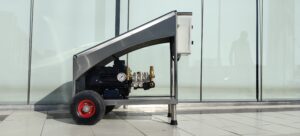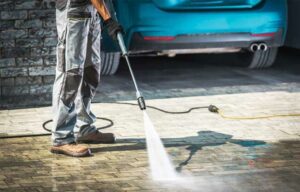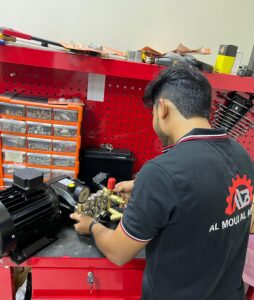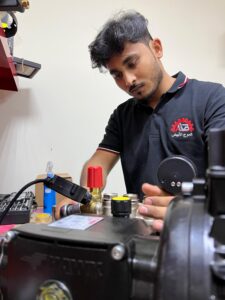How to Use an Electric Pressure Washer?

How to Use an Electric Pressure Washer
Electric pressure washers are powerful tools that make cleaning jobs faster and easier. Using a pressure washer safely and effectively is key for cleaning your driveway, car, or patio. This guide will take you step by step through the process.
Why Use an Electric Pressure Washer?
Key Benefits of Electric Car Pressure Washer
- Environmentally Friendly: Uses less water compared to traditional methods.
- Lightweight and Easy to Handle: Great for beginners.
- Affordable and Quiet: Ideal for home use.
Many people prefer electric pressure washers for their convenience and flexibility. They handle cleaning tasks quietly and without fumes, ideal for residential areas.
Common Uses
- Washing cars and bikes.
- Cleaning outdoor furniture.
- Removing dirt and grime from patios, driveways, and fences.
- Clearing mold and mildew from walls and walkways.
A pressure washer simplifies tough cleaning tasks, saving time and ensuring great results. They’re great for quickly cleaning large surfaces, making them look like new and keeping them hygienic.
Before You Start Commercial Pressure Washer
Safety First
- Read the Manual: Always read the instructions that come with your pressure washer. Each model may have unique features or requirements.
- Wear Protective Gear: Put on goggles and gloves to protect your eyes and hands. We also recommend wearing non-slip shoes.
- Look at the area and take away any items or debris. This will help prevent damage and keep the space safe while cleaning.
- Avoid Electrical Hazards: Keep the power cord dry and away from water. Use a Ground Fault Circuit Interrupter (GFCI) outlet for added safety.
- Keep Children and Pets Away: Ensure no one casually enters the cleaning area while you’re working.
Follow these safety tips for a smooth and worry-free cleaning experience! Pressure washers are powerful tools, so using them correctly helps prevent damage or injury.
Gather Supplies
You will need:
- An electric pressure washer.
- A garden hose.
- Cleaning detergent (if required).
- Protect your hands and eyes by wearing gloves and goggles whenever using your pressure washer. Take care and stay safe!
- A sturdy surface to place the machine.
Having everything ready before you begin will save you time and make the process more efficient. It also minimizes interruptions, letting you stay focused on the job.
Explore our high-pressure pumps selection for reliable performance and efficiency in every application!
Setting Up Your Portable Pressure Washer

1: Connect the Hose
- Attach one end of the garden hose to your home’s water supply.
- Connect the other end to the pressure washer’s water inlet. Ensure the connections are secure to prevent leaks.
This ensures a steady flow of water to the pressure washer, which is crucial for its operation. Any interruptions in water flow can affect performance and may damage the machine.
2: Attach the High-Pressure Water Gun
- Secure the spray gun to the pressure washer hose. Make sure the connection is tight to avoid leaks.
- Check the hose for any kinks or damage that could restrict water flow.
3: Select the Right Pressure Washer Nozzles
- Most pressure washers come with replaceable nozzles:
- 0-degree nozzle: For tough stains and heavy-duty cleaning. Use with caution to avoid damage.
- 15-degree nozzle: For general cleaning of hard surfaces like concrete or brick.
- 25-degree nozzle: For light-duty tasks such as washing cars or outdoor furniture.
- 40-degree nozzle: For delicate surfaces like windows and wooden decks.
- Choose a nozzle based on your cleaning task. Incorrect nozzle selection can result in either ineffective cleaning or damage to the surface.
4: Plug It In
- Plug the pressure washer into a grounded electrical outlet. Avoid using indoor outlets to minimize risks.
- Ensure you use an outdoor extension cord rated for the washer’s power if needed. Avoid overloading the circuit.
Proper setup guarantees that the pressure washer will work efficiently and safely. Skipping any of these steps could lead to operational issues or potential hazards.
Using the High-Pressure Washer
1: Turn On the Water Supply
- Fully open the water supply tap. Low water flow can overheat your machine.
- Let water flow through the washer for a few seconds to remove air bubbles and ensure smooth operation.
2: Power On the Pressure Washer
- Switch on the machine following the instructions in the manual. Listen for any unusual noises, which could indicate a problem.
3: Start Cleaning
- Test Spray: Start by testing the spray on a small, hidden area to ensure it’s safe for the surface.
- Maintain Distance: Keep the nozzle 1-2 feet away from the surface to prevent damage and ensure even cleaning.
- Use a Sweeping Motion: Sweep the spray gun back and forth for a smooth, even clean. Avoid focusing on one spot for too long.
- Apply Detergent (Optional):
- Attach the soap nozzle or switch to the detergent setting on the machine.
- Apply detergent from bottom to top to prevent streaks.
- Let it sit for a few minutes to break down dirt, but don’t let it dry.
- Switch back to a regular nozzle and rinse thoroughly from top to bottom.

Tips for Different Surfaces
- Concrete and Driveways: Use a 15-degree nozzle for tough dirt and stains. For large areas, try a surface cleaner attachment—it makes the job faster and easier!
- Wooden Decks: Use a 25- or 40-degree nozzle to avoid gouging the wood. Test on a small area first.
- Cars and Bikes: Use a 40-degree nozzle and avoid high pressure on sensitive parts like mirrors or paint. For stubborn dirt, use a brush attachment.
Follow these steps for a thorough, damage-free clean. Using the right technique boosts results and keeps your surfaces and machine in great shape for longer.
After Cleaning
1: Turn Off the Machine
- Switch off the pressure washer.
- Unplug it from the outlet. Never leave the machine plugged in when not in use.
2: Release Pressure
- Pull the spray gun trigger to release any remaining pressure. This helps stop accidental discharge and lets the pressure out of the system.
3: Disconnect and Store
- Hose and Nozzle:
- Disconnect the garden hose and spray gun.
- Remove and clean the nozzle. Store nozzles in their designated holder to avoid loss or damage.
- Drain Water:
- Empty water from the machine to prevent freezing or damage, especially in colder climates.
- Store Properly:
- Coil the cords neatly to avoid tangles and damage.
- Store in a dry place, away from direct sunlight or extreme temperatures.
Storing your pressure washer properly keeps it in great shape for next time. Neglecting this step can lead to unnecessary wear and tear.
Maintenance Tips high pressure car washer

Cleaning the Filter
- Check the water inlet filter regularly for debris or clogs.
- Clean it under running water if needed. A clean filter keeps water flowing smoothly and protects the machine’s internal parts.
Inspect the Nozzles
- Use a nozzle cleaning tool to clear any blockages. Blocked nozzles can reduce performance and lead to uneven spray patterns.
Check for Leaks
- Inspect hoses and connections for wear and tear. Replace damaged parts immediately to avoid water waste and inefficiency.
Routine maintenance extends the lifespan of your pressure washer and ensures it operates at peak efficiency. A little effort now goes a long way in boosting performance over time.
Explore our Pressure Washer category to find the perfect cleaning solution for every tough stain and surface!
How to Check and Maintain Pressure Washer Pump Oil Level

Why Is Oil Important for Your Pressure Washer Pump?
Oil keeps the pump running smoothly. It cuts friction, prevents overheating, and helps your pump last longer.
When Should You Check the Oil?
- Before each use: Always check the oil level to make sure it’s at the right level.
- After every 50 hours of use: You should replace the oil to keep the pump working well.
Steps to Check the Oil Level
- Turn off the machine: Make sure the pressure washer is off and cool before checking the oil.
- Locate the pump: Find the pump, usually near the bottom of the washer.
- Check the sight glass or dipstick:
- Some pumps have a small window (sight glass) where you can see the oil level.
- Others come with a dipstick. Pull it out, clean it, and reinsert to check the oil level.
- Look for proper level: The oil should be between the “low” and “full” marks.
How to Add or Change the Oil
- Adding oil: If the oil level is low, top it up with the maker’s recommended oil. Slowly pour it into the pump.
- Changing oil:
- Remove the drain plug or tilt the pump to drain the old oil.
- Refill with fresh oil to the correct level.
What Kind of Oil Should You Use?
Always check the manual for the correct type of oil. Most pumps use non-detergent oil designed for pressure washers.
Signs Your Pump Needs an Oil Check
- Unusual noises
- Overheating
- Visible leaks or smoke
Quick Tips for Safe Maintenance
- Keep the area around the pump clean.
- Use gloves to avoid contact with oil.
- Dispose of old oil responsibly.
Regularly checking and maintaining the oil level keeps your pressure washer pump in top condition and extends its lifespan!
Troubleshooting Common Issues
Low Pressure
- Ensure the water supply is fully open. Partial flow can make the machine less effective.
- Check the hose for kinks or blockages. Even a small obstruction can impact pressure.
- Clean the nozzle to remove dirt or debris.
No Water Flow
- Verify that the garden hose is connected properly. Loose connections can disrupt water flow.
- Inspect the inlet filter for clogs. Cleaning it may resolve the issue.
Machine Won’t Start
- Check the power cord and outlet. Ensure the outlet is functional by testing it with another device.
- Reset the circuit breaker if necessary. Some machines have built-in safety features that need to be reset.
Knowing how to troubleshoot common problems will save you time and frustration. It also reduces the need for expensive professional repairs.
Frequently Asked Questions
How Often Should I Use a Pressure Washer?
- This depends on your cleaning needs. For example:
- Driveways: Every 3-6 months.
- Cars: Either weekly or every two weeks.
- Patio Furniture: Once a month.
What Kind of Detergent Should I Use?
- Use detergents specifically designed for pressure washers. Avoid using bleach or harsh chemicals, as they can damage the machine and surfaces.
Using the right tools and methods is key to getting great cleaning results. Take the time to familiarize yourself with your machine and its features to maximize its performance.
Upgrade your car cleaning routine with a powerful car washer machine—designed for effortless, professional-quality results at home!
Final Thoughts
Using an electric pressure washer is simple and effective when you follow the right steps. With proper setup, operation, and maintenance, you can enjoy a clean home and outdoor space without the hassle. Always remember to prioritize safety and consult your machine’s manual for specific instructions.
Pressure washers are a versatile and valuable tool for homeowners. Whether you’re tackling small jobs or large projects, the satisfaction of a spotless surface is well worth the effort. Make sure to follow the guidelines to get the job done efficiently and effectively. Best of luck with your cleaning!
Discover HAWK International, the trusted supplier of our high-pressure pumps, renowned for exceptional quality and performance.
